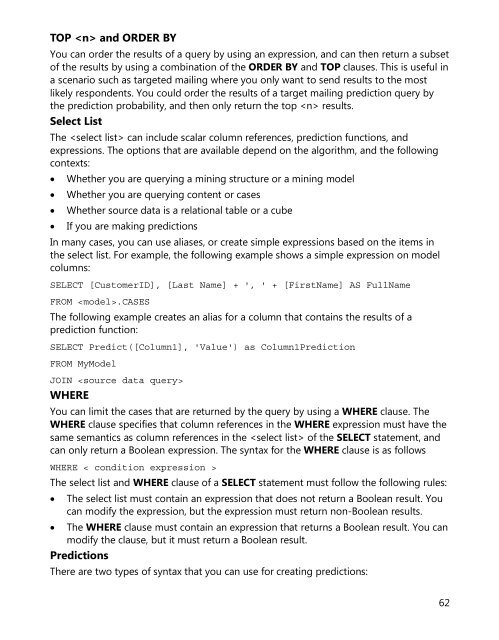Data Mining Extensions - DMX - Reference
Create successful ePaper yourself
Turn your PDF publications into a flip-book with our unique Google optimized e-Paper software.
TOP and ORDER BY<br />
You can order the results of a query by using an expression, and can then return a subset<br />
of the results by using a combination of the ORDER BY and TOP clauses. This is useful in<br />
a scenario such as targeted mailing where you only want to send results to the most<br />
likely respondents. You could order the results of a target mailing prediction query by<br />
the prediction probability, and then only return the top results.<br />
Select List<br />
The can include scalar column references, prediction functions, and<br />
expressions. The options that are available depend on the algorithm, and the following<br />
contexts:<br />
• Whether you are querying a mining structure or a mining model<br />
• Whether you are querying content or cases<br />
• Whether source data is a relational table or a cube<br />
• If you are making predictions<br />
In many cases, you can use aliases, or create simple expressions based on the items in<br />
the select list. For example, the following example shows a simple expression on model<br />
columns:<br />
SELECT [CustomerID], [Last Name] + ', ' + [FirstName] AS FullName<br />
FROM .CASES<br />
The following example creates an alias for a column that contains the results of a<br />
prediction function:<br />
SELECT Predict([Column1], 'Value') as Column1Prediction<br />
FROM MyModel<br />
JOIN <br />
WHERE<br />
You can limit the cases that are returned by the query by using a WHERE clause. The<br />
WHERE clause specifies that column references in the WHERE expression must have the<br />
same semantics as column references in the of the SELECT statement, and<br />
can only return a Boolean expression. The syntax for the WHERE clause is as follows<br />
WHERE < condition expression ><br />
The select list and WHERE clause of a SELECT statement must follow the following rules:<br />
• The select list must contain an expression that does not return a Boolean result. You<br />
can modify the expression, but the expression must return non-Boolean results.<br />
• The WHERE clause must contain an expression that returns a Boolean result. You can<br />
modify the clause, but it must return a Boolean result.<br />
Predictions<br />
There are two types of syntax that you can use for creating predictions:<br />
62









